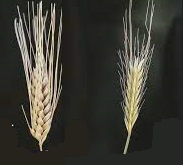
The Wheat and the Weeds
The Parable of the Weeds (Matthew 13:24-30, 36-43) can be seen as a metaphor on spiritual warfare that goes on in the world. The field represents the world, the man who sows the good seed represents the Son of Man and the enemy who sows the weed represents the devil. The good seed represents the children of the kingdom, while the weeds represent the children of the evil one. As the wheat grew, the weeds appeared and grew alongside the wheat.
The type of weeds referred to in the parable are tares. Tares grow among grain, particularly wheat and tares resemble wheat in the early stages of growth.
Spiritual warfare is often thought of in terms of exorcisms and angels battling demons. However, spiritual warfare occurs more commonly in everyday life, in terms of each person’s battle against temptation and sin. Looking back at the parable, weeds can inhibit the growth of plants by robbing them of water and nutrients; and if left unchecked, they can cause serious damage. Metaphorically speaking, the children of the evil one, whether they be human or evil spirits, can inhibit or cause damage to the spiritual growth of the children of God; they can tempt and influence God’s children, and they can cause situations which hinder God’s children from doing good.
In the parable, one of the things that raises questions is why the Master allowed the weeds to grow alongside the wheat until harvest time? Isn’t it best to get rid of weeds as soon as possible? When asked if he wanted the weeds to be pulled out, the Master replied, “No, let them grow together until harvest; then at harvest time I will say to the harvesters, ‘First collect the weeds and tie them in bundles for burning; but gather the wheat into my barn.’” (Matthew 13:29-30)
Even though we all know that weeds cannot turn into wheat, in the bigger context, the weeds in the parable can also represent sinners who have not yet repented of their sins. Just as the master in the parable was willing to wait until harvest time to separate the weeds from the wheat, God allows the sinner time to repent.
The crucial point in understanding this parable lies in determining who are the ‘children of God,’ and who are the ‘children of the evil one.’ The First Letter of John provides an answer: “The children of God and the children of the devil are made plain; no one who fails to act in righteousness belongs to God, nor anyone who does not love his brother. For this is the message you have heard from the beginning: we should love one another, unlike Cain who belonged to the evil one and slaughtered his brother. Why did he slaughter him? Because his own works were evil, and those of his brother righteous. Everyone who hates his brother is a murderer, and you know that no murderer has eternal life remaining in him. The way we came to know love was that He laid down His life for us; so we ought to lay down our lives for our brothers. If someone who has worldly means sees a brother in need and refuses him compassion, how can the love of God remain in him? Children, let us love not in word or speech, but in deed and truth.” (1John 3:10-12, 15-18)
John admonished the early Christians to turn away from hate and to love one another in deed and in truth; this message applies to all of us. Our time in the world is the time allotted for our conversion. While in this world, sinners are not yet definitively excluded from God’s kingdom. However, the final reckoning will surely come; Jesus said: At the end of the age, the Son of Man will send his angels, and they will collect out of His kingdom all who cause others to sin and all evildoers. They will throw them into the fiery furnace, where there will be wailing and grinding of teeth. Then the righteous will shine like the sun in the kingdom of their Father. Whoever has ears ought to hear. (cf. Matthew 13:40-43)